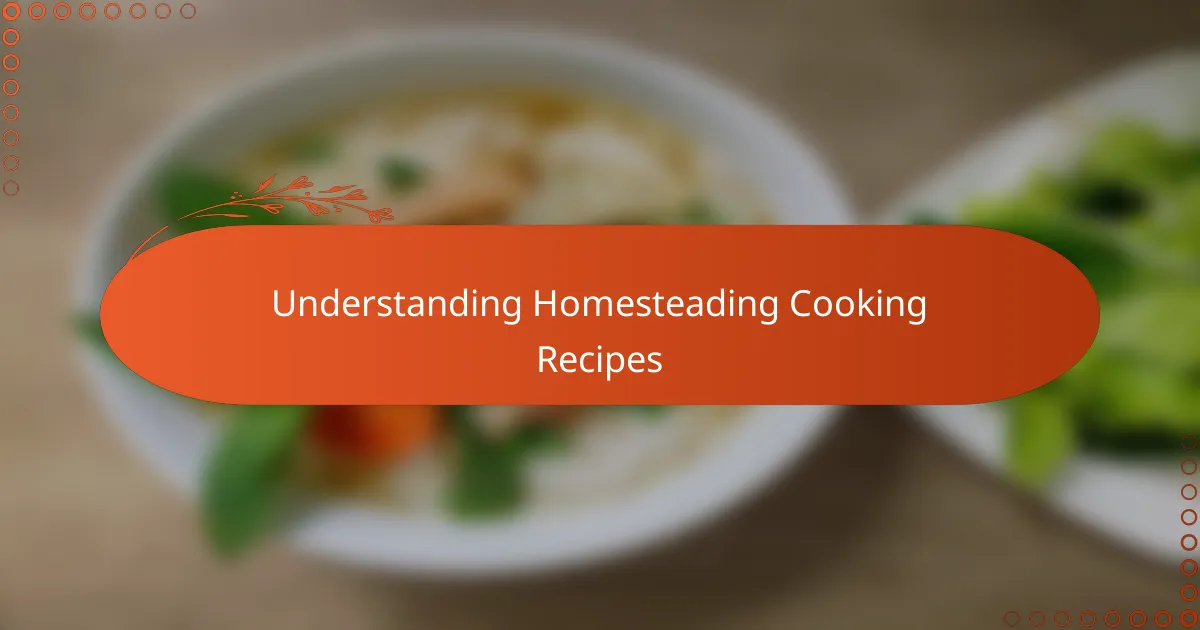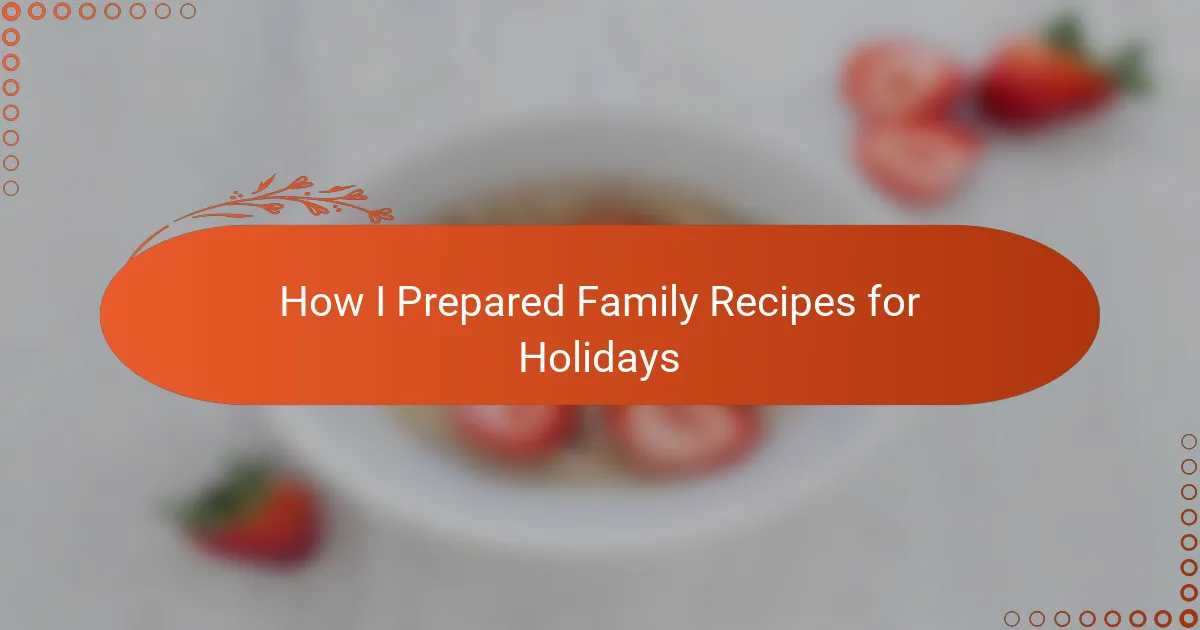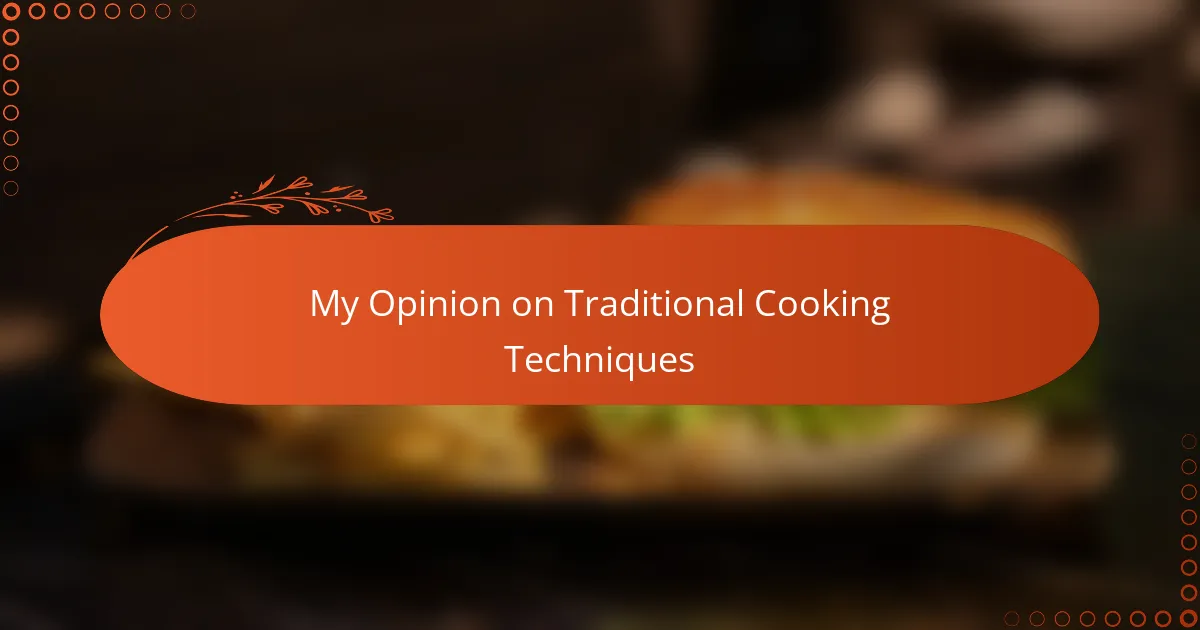Key takeaways
- Homesteading cooking recipes connect us to the past and encourage mindfulness in ingredient selection.
- Essential kitchen tools, like a cast-iron skillet and kitchen scale, enhance the holiday cooking experience and ensure accuracy.
- Choosing traditional family recipes involves balancing nostalgia with practicality to create warmth and comfort.
- Preparing ingredients from scratch adds personal meaning and connection to the meal, enhancing the overall cooking experience.

Understanding Homesteading Cooking Recipes
Homesteading cooking recipes are more than just instructions—they’re a way to connect with the past and nourish the present. When I first started exploring these recipes, I realized they carry stories and traditions that have been passed down through generations. Have you ever noticed how a simple dish can evoke memories of family gatherings and simpler times?
One thing that stands out to me about homesteading recipes is their emphasis on using ingredients you can grow, raise, or preserve yourself. This connection to the land adds a unique depth to every meal. It made me appreciate the effort behind each ingredient and inspired me to be more mindful about what I bring to the table.
These recipes often balance practicality and flavor in ways modern cooking sometimes overlooks. For example, incorporating homemade preserves or fresh herbs from my garden brought a freshness that no store-bought substitute could match. Isn’t it fascinating how old-fashioned methods hold such wisdom for today’s cooks?

Essential Tools for Holiday Cooking
When I dive into holiday cooking, the right tools make all the difference. I’ve learned that having a sturdy cast-iron skillet and a reliable Dutch oven can turn even the most complex recipes into joyful experiences. Don’t you find it satisfying when your tools just seem to understand the rhythm of preparation?
One tool I can’t live without during the holidays is a trusty kitchen scale. Measuring ingredients precisely, especially for family recipes that have been handed down, feels like honoring the tradition. I remember once underestimating the flour, and the texture of my grandmother’s pie was just off—tools help me avoid that disappointment now.
Of course, some might overlook the importance of good knives and sharp peelers, but to me, they’re essential for efficiency and safety. I still recall the first time a dull knife slowed me down; it made me appreciate how the right equipment can save precious time and keep the cooking flow smooth. Have you noticed how the best tools simplify even the busiest holiday kitchens?

Selecting Traditional Family Recipes
Choosing which traditional family recipes to prepare always feels like a delicate balance between honoring the past and considering what my family will enjoy today. I tend to lean towards dishes that carry a story—like my great-aunt’s cinnamon rolls that spark memories of cozy winter mornings. Have you ever found yourself drawn to a recipe simply because it reminds you of someone you love?
Sometimes, I sift through faded handwritten cards and well-worn cookbooks, paying attention to those recipes that have been made year after year. It’s in those little notes—words like “Mom’s favorite” or “Grandpa’s special”—that I find the true gems worth reviving. This process makes me feel connected to generations before me, as if their hands are guiding mine in the kitchen.
I also ask myself, which recipes resonate with my current holiday traditions? There’s no point in preparing something too complicated or unfamiliar when the goal is to bring warmth and comfort. I’ve learned that selecting recipes that are both meaningful and manageable is key to creating joy without stress. What traditions do you find essential when deciding what to cook?

Preparing Ingredients from Scratch
Preparing ingredients from scratch always feels like a labor of love to me. When I grind my own flour or churn fresh butter, it’s as if I’m stepping into the shoes of my ancestors, honoring their resourcefulness. Have you ever noticed how those simple, homemade elements bring such a rich texture and flavor that you just can’t get from store-bought?
I remember the first time I made my own chicken stock by simmering leftover bones and vegetables—it filled the house with warmth and nostalgia. It’s not just about saving money or knowing what’s in the food; it creates a connection to the meal that feels deeply personal. Does taking the extra time to prepare ingredients from scratch add a sense of meaning to your holiday cooking too?
Sometimes, the process is challenging, especially when adapting family recipes to small-batch homemade ingredients. Yet, there’s a special satisfaction in seeing the transformation happen in your own kitchen. The aroma of freshly grated nutmeg or hand-cracked eggs instantly transports me to those cherished holiday moments, making all the effort worthwhile.

Step-by-Step Holiday Recipe Preparation
Taking holiday recipe preparation step-by-step has always been my secret to staying calm in the kitchen. I start by mapping out each dish’s components and timing, which helps me avoid the chaos of juggling too many pots at once. Have you ever tried lining up ingredients like little soldiers on the counter? It’s a simple trick that instantly clears my mind and sets a confident tone for the cooking ahead.
Once I begin, I focus on one task at a time—whether that’s chopping vegetables or simmering broth—because rushing through everything only leads to mistakes. I remember one holiday when I tried to multitask too much and ended up burning the cranberry sauce; since then, slowing down feels like a quiet act of respect for the recipe and my family’s tradition. Isn’t it interesting how stepping through recipes methodically can turn holiday cooking from stress into something almost meditative?
Timing, of course, is everything. I often start dishes that take longer early in the day, saving quicker steps like garnishes or fresh bread for later. Over time, I’ve learned that prepping certain ingredients in advance—like peeling apples or measuring spices—frees up space to focus on the heart of the recipe when guests arrive. Doesn’t that sense of preparation make the holiday table feel even more inviting?

Tips for Cooking Family Recipes Successfully
One tip I’ve found invaluable is to taste as you go, especially when working from family recipes that sometimes don’t have exact measurements. It’s amazing how a little pinch more salt or a splash of acid can bring those familiar flavors to life. Have you ever caught yourself adjusting a recipe mid-cook and suddenly feeling like you’re really part of the family tradition?
Another thing I pay close attention to is managing my time wisely. Family recipes often involve multiple steps or components, and I’ve learned that breaking the work into manageable chunks prevents that frantic last-minute rush. It reminds me of when I first tried to prepare my grandmother’s feast, and pacing myself turned it from a stressful ordeal into a joyful experience.
Finally, I always remind myself to embrace imperfections. Sometimes the dish looks a little different or tastes slightly off from memories, but that’s part of the process. It’s the love and intention behind the cooking that truly make family recipes special. After all, don’t you think those small variations add personality and keep the tradition alive in a real, human way?



